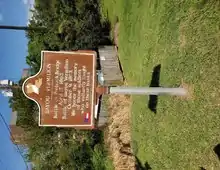Battle of Vermillion Bayou
The Battle of Vermillion Bayou or Battle of Pinhook Bridge[2] was fought on April 17, 1863,[3][4] the third battle in a series of running battles between Union Major General Nathaniel Prentice Banks and Confederate Major General Richard Taylor. The battle was fought after both the Battle of Fort Bisland and the Battle of Irish Bend. On October 9, 1863 a skirmish with Confederate & Federal cavalry occurred at the same location.[5]
| Battle of Vermillion Bayou | |||||||
|---|---|---|---|---|---|---|---|
| Part of the American Civil War | |||||||
| |||||||
| Belligerents | |||||||
|
|
| ||||||
| Commanders and leaders | |||||||
| Nathaniel P. Banks | Richard Taylor | ||||||
| Units involved | |||||||
|
XIX Corps CONNECTICUT-- 13th, 24th and 25th Infantry. LOUISIANA-- 1st Cavalry (Co. "F"). MAINE-- 22d and 26th Infantry. MASSACHUSETTS-- 2d Battery Light Arty.; 52d Infantry. NEW YORK-- 6th, 91st, 131st and 156th Infantry. UNITED STATES--Battery "L" 1st Arty., Battery "C" 2d Arty.</ref> [1] | Army of Western Louisiana | ||||||
| Casualties and losses | |||||||
| unknown, 91st NY Infantry "2 enlisted men wounded" | unknown | ||||||
Prelude
After Nathaniel Prentice Banks had outmaneuvered Richard Taylor's Army of Western Louisiana out from the Bayou Teche region, he continued his movements towards his main objective of Alexandria, Louisiana. The Confederates were trying to slow him down as much as they could and they once again tried slowing him down right outside of Vermillion Bayou.
Battle

As Richard Taylor's small army was withdrawing up the Teche, they crossed a bridge going over Vermillion Bayou. In order to slow Banks' army down, Taylor's men lit the bridge on fire and stopped for a rest. Banks, who was in pursuit of Taylor, split his army into two columns and sent one towards the bridge and the other column around the side.
As soon as the first column came within sight of the bridge, Confederate artillery began shelling the Union soldiers. After a while, Union artillery came up and a series of counter-battery exchanges ensued.
During the night, Taylor, knowing himself to be outnumbered, withdrew his force again.
Aftermath
Though Taylor had not dealt Banks a defeat, he was continually slowing Banks down from reaching Alexandria, Louisiana, and his ultimate objective of Port Hudson, Louisiana.

Notes
- "NPS Louisiana Civil War Battles". Retrieved 2 October 2020.
- "Bayou Vermilion Marker". Historical Marker Database. Retrieved 17 April 2016.
- "Vermillion Bayou". National Park Service. Retrieved 17 April 2016.
- "Report of Colonel Nicholas W. Day, 131st New York Infantry". United States War Department, Ohio State University. Retrieved 17 April 2016.
- "Report of Brigadier General Stone, 13th Army Corps". United States War Department, Ohio State University. Retrieved 18 April 2016.
References
- Ayres, Thomas., Dark and Bloody Ground : The Battle of Mansfield and the Forgotten Civil War in Louisiana, Cooper Square Press, 2001.
- Parrish, T. Michael, Richard Taylor, Soldier Prince of Dixie, University of North Carolina Press, 1992.
- Taylor, Richard, Destruction and Reconstruction : Personal experiences of the late war, Time-Life Books, 1983.